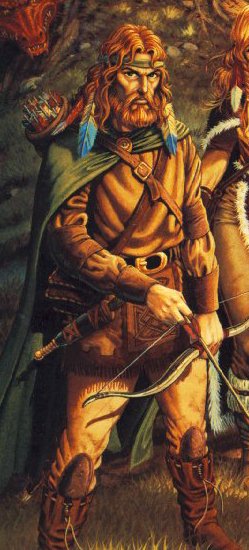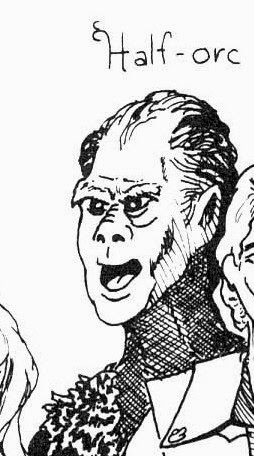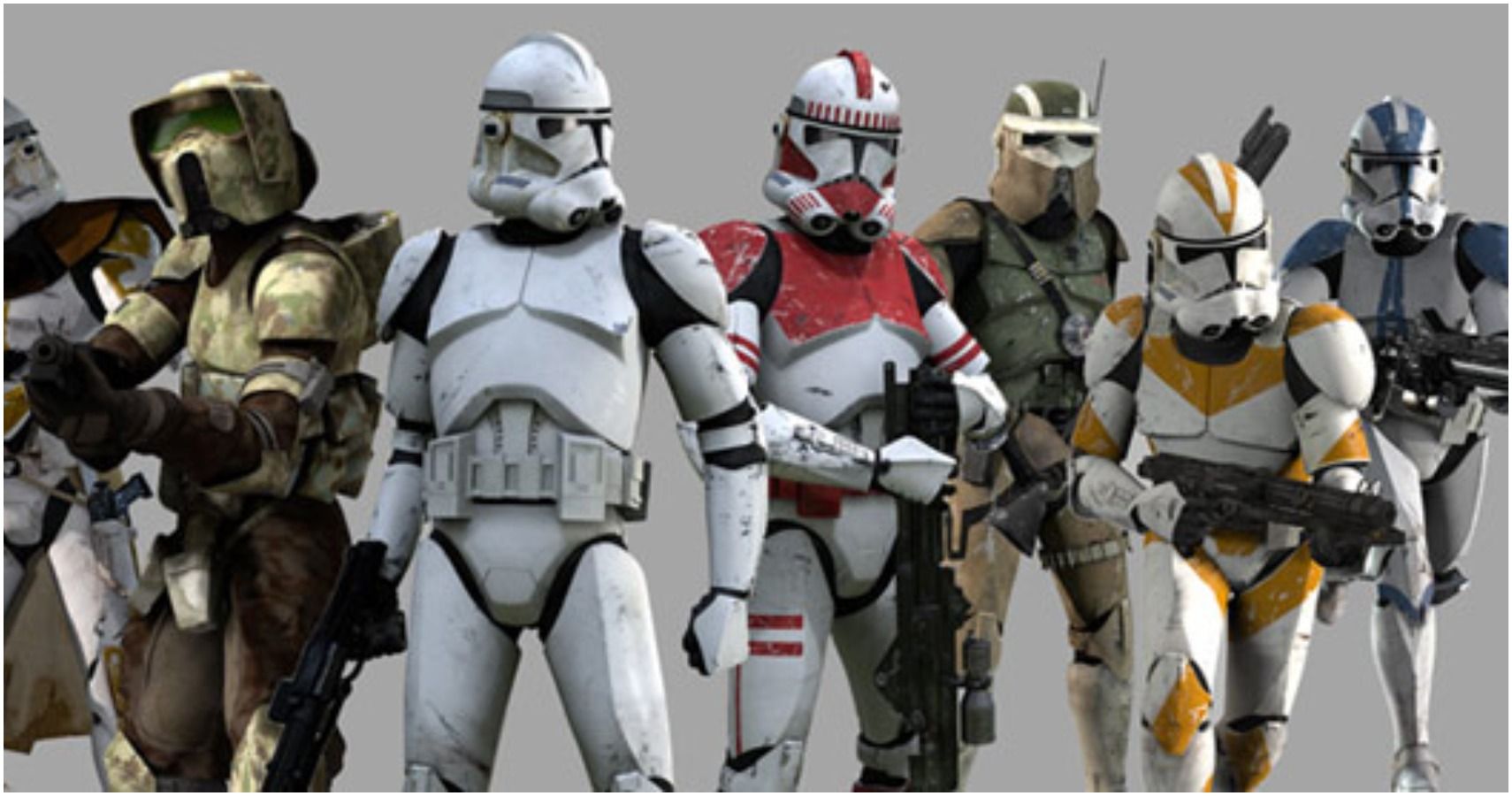
(This is a series. First post is here, second is here, third is here, and yesterday's is here.)
(This is a much longer post as we're covering both Half-Elves and Half-Orcs.)
Rounding out the playable races in the Advanced Dungeons & Dragons 1st Edition Player's Handbook are the half-breeds: Half-Elf and Half-Orc.
If the Halfling is the most Tolkien thing in the game, the Half-Orc in particular is a runner-up and many lump the Half-Elf with it.
That is not necessarily the case for Half-Elves. Elves and Men mixing predates Tolkien, and the "not fully part of either" trope does not apply to Elros or Elrond (or Arwen) so that came from somewhere else. Nor does it really apply to Half-Orcs either; they clearly favor their Orc side, regardless of how Mannish they seem, and it is rare for any to not play into the inherent and innate strengths that such miscengenation engenders.
Again, this isn't the later editions where half-witted Bowlderization was the rule of the day. What you are largely determined who you are, and it does not matter if that was a deliberate design decision or not- that's what's on the page, so that's how it is.
The result is that, much like how sub-classes exist to flesh out concepts and fill in gaps, so do half-breeds. In this case, we're looking at what a native of a liminal space (the space between two races) looks like- and how the non-Man halves have more to do with these two races than one would expect.
The Half-Breeds
Ability Score Modifiers:
- Half-Elf: None
- Half-Orc: +1 Strength/+1 Constitution/-2 Charisma
Ability Score Limits:
- Male Half-Elf: Strength (3/18), Intelligence (4/18), Wisdom (3/18), Dexterity (6/18), Constitution (6/18), Charisma (3/18)
- Female Half-Elf: Strength (3/17), Intelligence (4/18), Wisdom (3/18), Dexterity (6/18), Constitution (6/18), Charisma (3/18)
- Male Half-Orc: Strength (6/18), Intelligence (3/17), Wisdom (3/14), Dexterity (3/17), Constitution (13/19), Charisma (3/12)
- Female Half-Orc: Strength (6/18), Intelligence (3/17), Wisdom (3/14), Dexterity (3/17), Constitution (13/19), Charisma (3/12)
- (Note: Half-Orcs use unmodified Charisma scores when interacting with other half-orcs, as per PHB p 17.)
Class Limits:
- Cleric: (Half-Elf) 5th; (Half-Orc) 4th
- Druid: (Half-Elf) Unlimited; (Half-Orc) Not Allowed
- Fighter: (Half-Elf) 6th (STR 16-)/7th (STR 17)/8th (STR 18+); (Half-Orc) 10th
- Paladin: Not Allowed
- Ranger: (Half-Elf) As Fighter; (Half-Orc) Not Allowed
- Magic-User: (Half-Elf) 6th (INT 16-)/7th (INT 17)/8th (INT 18+): (Half-Orc) Not Allowed
- Illusionist: Not Allowed
- Thief: (Half-Elf) Unlimited; (Half-Orc) 6th (DEX 16-)/7th (DEX 17)/8th (DEX 18+)
- Assassin: (Half-Elf) 11th; (Half-Orc) Unlimited
- Monk: Not Allowed
- Multi-Class Combinations:
- (Half-Elf) Cleric/Fighter, Cleric/Ranger, Cleric/Magic-User, Fighter/Magic-User, Fighter/Thief, Magic-User/Thief, Cleric/Fighter/Magic-User, Fighter/Magic-User/Thief
- (Half-Orc) Cleric/Fighter, Cleric/Thief, Cleric/Assassin, Fighter/Thief, Fighter/Assassin
Racial Abilities:
- Half-Elf:
- 30% resistance to Charm and Sleep spells.
- Infravision: 60 feet
- Detect Secret Doors: (Passive) When within 10 feet, 1 in 6; (Active) 2 in 6 for a secret door/3 in 6 for a concealed door
- Half-Orc:
- Infravision: 60 feet
- Presumed to be in the 10% of half-breeds that can pass for Mannish
Aging:
- (Half-Elf) Young Adult (24-40), Mature (41-100), Middle Age (101-175), Old (176-250), Venerable (251-325), Upper Limit (705)
- (Half-Orc) Young Adult (12-15), Mature (16-30), Middle Age (31-45), Old (46-60), Venerable (61-80), Upper Limit (99)

Half-Breed Cultures
The fact that both races are able to multi-class implies that both races are far more influenced by their Elf/Orc half than their Mannish half, and the fact that a race who's lifespan is shorter than those of Men can multi-class implies that this is a quality that is inherent in the monsters and demi-human kinds and lacking in Men generally.
I want you to consider that these two races exist not as accidents or byproducts of standard activities, but rather have been found to be very useful by the non-Mannish side.
I want you to consider that, save for a few notable exceptions, neither half-breed race exists as an entity unto itself but rather as an adjunct to its inhuman half that exists to handle affairs concerning or adjacent to Men and Man's civilizations. Half-Elves are used by Elves as part of the latter's strategy of buffering, while Half-Orcs are used by Orcs (and their masters, who are likely the ones actually making this happen) as both a leadership cadre and an elite vanguard.
First, the Half-Elf Situation.
We're meant to think that they're the (usually) illegitimate children of inter-racial affairs. Maybe they're more like another questionable creation instead.

Half-Elves mature in a fraction of the time of an Elf, but are equally capable of doing what Elves can do. Furthermore, they are able to take up professions that otherwise Elves must call upon allied Men to perform on their behalf.
Why would an Elf ruler, whose chief responsibility is to see to the security of his own kind, not see the Half-Elf as a controlable asset? Quickly raised and trained to standard, able to be deployed in significant numbers without undue risk to Elfkind, and then able to be humanely retired when no longer fit for purpose- either among the Elves that created them or the Men that are often allied to them.
It would not take any wrongdoing on the part of the Elves to make this happen. The Elf maids would have no problems finding suitable and available Men to sire a new Half-Elf cohort with, and given that this would happen years before the need arrives most of those Men would not connect cause and effect by the time that the danger those Half-Elves are to address comes upon one and all.
The only training issue would be in finding Druids and Rangers, but in answering that question one also likely solves another problem; the Druids and Rangers take in Half-Elves that cannot find places among their Elf patrons, meaning that the longer-lives Half-Elves come to dominate Druid and Ranger societies over time, especially the Druids (where the Half-Elf has no level limits) where such it is reasonable to presume that Half-Elves dominate Druid leadership.
This solves the Elf issue with major warfare; if the Elf leadership can see it coming soon enough, they will sire a Half-Elf cohort to bulk out their numbers, especially where Elf racial traits are depreciated or useless (such as traditional mass battles, where "Elf" infantry is likely Half-Elves), commanded by Elf leaders and retired some time after that major war concludes.
The standing Elf army, therefore, is akin to the modern professional rapid-reaction force or veteran core around which mobilized manpower forms- first as training units, then as field armies. The heroic Half-Elves that emerge due to these incidents are retained as long as possible lest another cohort need to be raised before the emergency requiring them is over, in the manner that successful pilots rotate back to train the next cadre.
Thus do we have an explanation for the rise and fall of the Half-Elf population within a setting; Elves sire then as needed, employ them to bulk up their own numbers (and thus reduce risk of an Elf dying permanently; Half-Elves can be raised, while Elves cannot), and then seeing to their humane retirement once that threat has passed and they get too old to remain fit for purpose.
A significant subset turn to Druidism to square this experience with something they can understand, a form of naturalistic Stocism turned into a spiritual devotion.
You would think this would breed resentment, and no doubt that this occurs, but as a race they do not because their Elf parents do care for them as best that Elves are able- it's just that this relationship is akin to a Man caring for a beloved dog. The Man loves his dog, protects it as best he can, trains it well, etc. but no matter what that dog will get old and die well before the Man does- so it is unwise to get too attached.
Now compare how different it is for Half-Orcs.
Orcs are a cruel and brutal race that don't care if their young live or die. Half-Orcs will not be treated any differently; the only difference is if someone greater dominates the Orc sire and seeks to make use of the Man-passing Half-Orc.
The smarter Orcs, usually the leaders and shaman, do see the value of Half-Orcs and will taken them on if they prove their worth. Given how early they mature, that potential can show up by the time a Man-child learns to walk and talk. This is where Half-Orc Fighters often arise, proving their worth within a tribe's warriors before striking out on their own (or seeming to).
Clerics are often trained by tribal shaman, or evil cults that the Orcs are allied or associated with, but given the low potential this is considered a waste most of the time. Thieves, on the other hand, are where the leaner Half-Orcs end up; those that are lean but muscles end up Fighter/Thieves.
Then there's the Assassins.
Assassin societies are full of Half-Orcs, as that class is a blend of the wicked nature and cunning common to Thieves while showing some appreciation for skill at arms that Fighters are known for- albeit is a very specific and particular form of that. Fighter/Assassin Half-Orcs, therefore, are considered by would-be Dark Lords to be the best that you can get out of a Half-Orc; they can reach Name Level in both classes, and being capped at 10th level for Fighter isn't so bad compared to what it takes to reach and stay at the cap for Assassins (15th).
I speculate, therefore, that the Half-Orc is the result of an Assassin society some time in the past in their association with one or more Orc tribes. They wanted to create a cadre of reliable enforcers, and they succeeded well enough; the 90% that passed for full Orcs likely became the society's attempt to install a controlable puppet leadership on those Orc clans, while the (playable) 10% that can pass for Men are those retained by the society for operating in Man's civilizations.
I also speculate that enough of these Half-Orcs slipped out from under control to become independent agents; some climbed the power ladder within, others became warlords on the outside, and some (Thieves) joined various gangs or guilds. Despite this, would-be Dark Lords of all sorts exert a pull on all but the most atypical (Good-aligned) Half-Orcs due to the blood curse of their Orc sires pulling at their wills.
In short, the Half-Orc is heavily incentivized to conform to their Orc blood and live nasty, brutish, and often short lives of predation and Low-Trust living- up to the sort of living that we see in the biographies of mobsters, cartel leaders, and similar organized criminal sorts display.
These are not people with their own societies.
The Half-Orc does not live on his own. He lives either in the shadow of Man, or in the open with Orcs. Those that defy the curse of their blood are so few, and so far between, that each one who amounts to anything at all accure heroic stature purely by being the exception to a well-defined rule. If he does not conquer, he gets conquered and is made to serve until he either breaks free and conquers or dies serving someone who--at best--sees him as a disaposable tool.
The Half-Elf, far from the concept of him being disdained by the Elves, he is valued and cared for by them. So long as he does what his Elf family asks of him, and he meets their expectations, they will care for him and see that he retains his dignity in his infirmity and meets his death appreciated and loved by those who will outlive him tenfold because he did for them what they could not bear to risk to do themselves.
One is a whipped and starved dog. The other is a well-trained and loved dog. Yet both are still dogs, and dogs are better off with their masters than by themselves- and this is so even for those Half-Elves who turn to Druidism, for they replace the authority of their Elf family (often their mother's) with the authority of Nature Herself, whose love can be a colder comfort than any oddity of any Elf.
It is no surprise that the wise among the races pity the half-breeds, even as they are forced to cut them down or order them to their deaths.
That's a sad note to end the series on, but that is what is on the page played out as one would expect given what is written down.
(Note: Tomorrow is a commentary on the dominance of Thieves as Demi-human leaders.)
" "not fully part of either" trope does not apply to Elros or Elrond (or Arwen) so that came from somewhere else".
ReplyDeleteGiven that Tanis Half-Elven appears to have created the trope for AD&D half-elves, and Hickman is an old-school Trekkie, I'd suggest the most likely root is Mr. Spock.
Maybe. I'd dig through the literature informing the game also, just to be certain that nothing got missed.
ReplyDelete